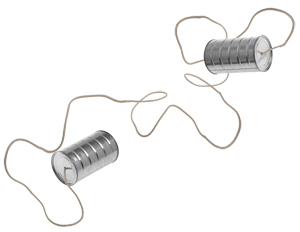
The room was filled with silent suspense. At one end of the long conference table sat the great coach. His large, muscular arms were crossed over his barrel chest. His head was tilted slightly forward. His jaw was set and his lower lip protruded slightly from the thoughtful frown on his face. From under his bushy eyebrows, his piercing eyes carefully examined each item, which had been strategically arranged for his inspection. Off to the side and away from the table sat two young salesmen.
They had just finished making the most important sales presentation of their careers. The top of the table was covered with a splendid array of trophies and awards: crystal glass trophies, polished pewter replicas with exquisite detail, engraved sterling silver bowls and an abundant and elegant display of other glittering award hardware samples. Finally, after several minutes, without saying a word, the coach pushed back from the table, stood up and walked around to the side of the table. Bending at the waist, the coach stretched his arm out across the table in front of the awards. In one continuous sweeping motion, he walked along the length of the table, raking all of the awards off the opposite end of the table and onto the floor. The crashing sound of metal and glass was almost deafening. The salesmen sat motionless in stunned disbelief. The coach walked back toward the two salesmen and settled, perching on the side of the table. “Create an award that appropriately embodies the significance of our achievement; an award that will cause people to remember our accomplishment; an award that symbolizes the highest level of excellence,” he said. From that charge came the birth of the Super Bowl Ring—the most sought-after prize in the NFL.
Why do we place such value on notoriety and symbols of achievement? On the surface, there does not seem to be much significance in a commemorative ring or a “good job” pat on the back. Yet, research in business and human behavior has revealed that praise and recognition are some of the most effective, yet least exploited methods of boosting morale and productivity in the workplace.
What makes us tick?
Physiologically, a neurotransmitter known as dopamine stimulates the parts of the brain responsible for producing feelings of pleasure, satisfaction, enjoyment and pride. This natural “buzz” doesn’t last very long. When we don’t get enough, we feel frustrated, anxious and unappreciated. Not surprisingly, most of us don’t get enough dopamine at work. An article in the Gallup Management Journal entitled “The Fourth Element of Great Managing” states, “Employees may be motivated by many different things, but they all strive for a surge of dopamine.”
In her article, “In Praise of Praising Your Employees,” Jennifer Robison states recognition for good work releases dopamine in the brain, which creates feelings of pride and pleasure. Better yet, dopamine cements the knowledge that more of that behavior will create more praise, resulting in another dopamine drench, and so on. This is why positive reinforcement works so well.
One of the finest examples of the effective use of positive reinforcement is predictably found in the entertainment industry—more specifically, video games. The interactive entertainment industry, worth $29 billion in 2005, is expected to grow to a value of $44 billion in 2011. No longer the domain of computer enthusiasts and high school dropouts, video games are being created by technical and creative professionals with college educations and white-collar incomes. The typical price of a new game today is $60, more than twice that of a DVD or Blu-ray disc, and global annual revenue from games now exceeds revenue from DVDs and Blu-ray discs combined. The reason for the rise of this previously fringe industry lies not only in technological advances, but also in the extensive manipulation of every human’s need for recognition.
A video game invites players to sit and literally twiddle their thumbs for hours on end. That would not be very exciting by itself, but the game designer creates an artificial experience based on the notion that the player will sit and twiddle his or her thumbs indefinitely in exchange for recognition. The player presses a button and, in return, is treated to something exciting on the screen—an engine is revved, a gun is fired, a spell is cast. If the player enters a state of suspended disbelief and embraces the reality of the game, every second the player spends with the game is potentially filled with shots of dopamine. Those little moments are linked and expanded into a more intense and engaging experience dependent on the time and effort put forth by the player. Essentially, everything that happens on the screen is rewarding the player’s actions; and remember, all the player did was twiddle his thumbs.
Video game players do not spend their time and money to win the Grand Prix, pilot fighter jets or save the world—they play because it feels good to win. Business owners and managers need to take a lesson. If the video game industry has anchored its success to the awareness of our biological drive for dopamine and its positive, addictive effects, then frequent recognition and praise should be a routine and consistent practice for managers.
A lesson in management
There is a monumental difference between playing a video game at home and desperately racing to achieve a sales quota, but the underlying motivation is the same—to achieve victory, to accomplish something. It is this connection between motivation and job performance that most managers tend to ignore, relying only on the almighty paycheck to keep the employee happy. Predictably, the paycheck often becomes the only motivation the employee has to do his job, resulting in a lethargic, disengaged mentality among the workforce. A common but inadequate solution to this problem tends to be one of negatives. “Do this or else.” The employee is pressured to perform better through threats and innuendoes of ensuing doom (e.g., pay cuts, layoffs, etc.). While this approach may improve employee performance temporarily, it only aggravates the employee’s mentality through the crippling effect of living in a constant state of fear.
The alternative lies in giving employees praise, recognition and encouragement. The value of giving employees positive reinforcement is measurably significant, with a Gallup survey finding 10- to 20-percent increases in revenue and productivity where managers regularly praised employees for good performance. Every bit of honest praise from the supervisor or manager translates into a victory in the mind of the employee, resulting in the release of dopamine, which builds positivity, engagement and initiative.
Just as productivity is increased by praise, so too is employee retention. The same Gallup study revealed that employees who said they were not adequately recognized at work were three times more likely to say they would quit in the next year. Other studies support this correlation, such as the 2010 Star-Ledger Wire Services report of The Conference Board’s findings, which revealed that job satisfaction is at a 22-year low with only 45 percent of those surveyed being satisfied with their jobs. Nearly one-quarter of respondents said they didn’t expect to be at their current jobs within a year.
Most staggering of all is the claim by the U.S. Department of Labor that the number-one reason people leave their jobs is they do not feel appreciated. With statistics showing that replacing an employee costs a company an estimated 250 percent of the departing person’s salary, expressing appreciation to employees should be at or near the top of every manager’s priority list.
More crucial to the day-to-day operations of business than employee retention is employee engagement—whether the employee is merely coasting along or doing everything with maximum efficiency and effectiveness. Praise helps foster this engagement, reminding employees that someone cares about their contributions. Praising an employee forces a manager to focus on that single individual for a moment, building the employee’s sense of significance and the bond between the employee and the organization. The strength of that bond is reflected in the employee’s engagement, productivity and initiative.
This, too, has been studied and confirmed with facts. For example, a 36-month study involving 40 global companies found that a “highly engaged employee population turned in significantly better financial performance than did low-engagement workplaces.” Specifically, there was a 5.75-percent difference in operating margins and a 3.44-percent difference in net profit margins. Furthermore, a study conducted for a prominent recognition company in 2008 found that manager-delivered recognition of employee performance boosted engagement so dramatically, the researchers compared the improvement to a turbocharger cranking up a sports car’s horsepower. In low-engagement workplaces, manager recognition of employee performance increased engagement by nearly 60 percent!
Praising employees’ success does not need to cost anything, and with overwhelming evidence showing its vast array of positive effects on organizations all over the world, this is a habit every manager should practice.
The most difficult part
As uncommon as it is for employees to receive praise, giving praise will often require managers to step outside their comfort zones. As a result, most managers and executives excuse themselves with an attitude that says, “If I don’t say anything, assume you’re doing a good job.” This “no news is good news” management philosophy may work well on machines with motors designed to run consistently until you hit the kill switch, but the human mind requires frequent positive feedback. Still, other managers dismiss their responsibility with the classic, “I don’t know how,” or, “I’m not good at it.” However, giving praise is a skill. Therefore, it can be learned, and excuses are not recorded on quarterly statements.
James Harter, Ph.D., Chief Scientist at Gallup and co-author of “12: The Elements of Great Managing” said, “Great managers are extremely effective in figuring out the best form of praise for each person. Some managers worry that they can give employees too much recognition. But, the research shows that it’s extremely difficult to do that as long as the recognition is right for the person.” There is no perfect technique managers can use to praise and encourage every employee, but research shows any form of praise is better than none at all. Different employees have different preferences. Some individuals prefer to be thanked or praised in private, while others enjoy publicity among their coworkers and peers. The best way to learn each employee’s preference is to ask.
Personal preferences aside, the following are several general guidelines every manager should follow:
- Give praise only when it has been earned.
- Be sincere and genuine.
- Praise people as individuals, one-on-one.
- Praise people as teams, publicly.
- Praise through tangible rewards.
- Be honest.
- Give due recognition to everyone.
It is also a good idea to think creatively about new ways to give people recognition. A book by Adrian Gostick and Chester Elton, “The Carrot Principle,” contains more than 125 methods of praising employees, including handwritten thank-you notes, awards ceremonies, afternoons at the movies and catered luncheons. There is also a wealth of ideas and information online for those willing to dig a little deeper into this effective management tool.
A little-known truth about praise is that it not only boosts the performance and morale of the person receiving the praise, but it also triggers a surge of dopamine in the person offering the praise, consequently acting as an accelerant throughout all levels of business. Praise is not only the rocket fuel of individual achievement, it is a powerful force of growth and success in the world of business.


